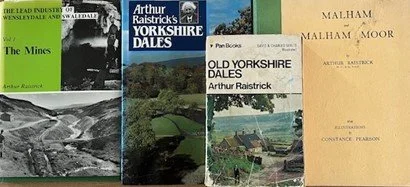Arthur Raistrick - Yorkshire Historian
The name of Dr Arthur Raistrick is known throughout the Yorkshire Dales as a prolific author writing from his extensive knowledge as a geologist and a field archaeologist. He brought new understanding of the landscapes of the Dales, Yorkshire and of the north of England in a way which inspired the readers to learn more about their local areas.
I cannot remember my life without the name of Dr Arthur Raistrick, his books were on my parent’s book shelves and now on mine.
I was delighted to hear, earlier this year, that a weekend event was to take place to celebrate Raistrick’s legacy; then even more excited to learn that the event was taking place in Grassington, North Yorkshire, my home.
The Yorkshire Geological Society organised and hosted the weekend event, The Life and Work of Arthur Raistrick, in July 2024. What a fabulous event this was, the Saturday being a series of lectures and the Sunday a choice of walking excursions related to Raistrick and his work.
Arthur Raistrick was born on 16th August 1896 and married Sarah E Chapman in 1930 [General Register Office; United Kingdom; Volume: 9a; Page: 35 www.ancestry.co.uk].
The following year Raistrick was living at 15 Devonshire Place, Jesmond, Newcastle upon Tyne with his wife Sarah Elizabeth, known as Elizabeth. [Tyne and Wear Archives; Newcastle-Upon-Tyne; Collection: Newcastle Electoral Registers; Reference Number: MD.NC/D/2/3/1931N www.ancestry.co.uk]
The Morpeth Herald and Reported, in 1933, advertised a WEA lecture Arthur Raistrick was to present in Ashington, Northumberland, titled ‘What is Coal?’, considering the history and composition of coal. He went on to write books on mining and the leadmines of the Yorkshire Dales. [Morpeth Herald 08 December 1933 Page 11 | findmypast.co.uk]
In 1939 Raistrick was a listed as a University Lecturer on the 1939 Register and still living at 15 Devonshire Place with Elizabeth. [The National Archives; Kew, London, England; 1939 Register; Reference: RG 101/2927J www.ancestry.co.uk].
Arthur and Elizabeth returned to Yorkshire living in Linton in Craven, the ideal location for him to continue his work in local history and writing his books and articles for the Dalesman.
When the Yorkshire Dales National Park was founded, in 1954, Arthur Raistrick was appointed as member of the West Riding Committee of the Park. [Dalesman’s Diary: August 2024 - The Yorkshire Dalesman]
Dr Arthur Raistrick died in Linton in 1991 [ General Register Office; United Kingdom; Volume: 2; Page: 2509 www.ancestry.co.uk]
A few of Arthur Raistrick’s books about the Yorkshire Dales
The weekend event on the life and work of Arthur Raistrick demonstrates the legacy he has left in local history in the Yorkshire Dales and the north of England.
Following insightful lectures on the Saturday I chose the outdoor meeting ‘The Visible and the Invisible in the Ancient Landscape North of Grassington’ on Sunday 21st July with the very knowledgeable Roger Martlew.
This was a visit to High Close, just to the north of Grassington above Town Head Farm, a 17C listed building. The photo below is the approach to High Close.
High Close is an example of the remains of a prehistoric field system with square and rectangular enclosures. The field was probably used for crops and may date as far back as the Iron Age and possibly the Bronze Age. High Close field systems, Grassington – Out of Oblivion
It is hard to imagine life in the area over 2000 years ago. This was a period of change with weapons and tools made from iron, woodland was cleared and a rise in population. A ruling class formed to defend the people and the land, with the later threat of the Roman invasion and then about 500 years after the Anglo Scandinavian influence has been found in the Dales. Anglo-Scandinavian – Out of Oblivion
I just wish I could have been in several places at the same time to have been able to join more than one of the fascinating walks based on Arthur Raistrick’s legacy. Maybe another time.
Dr Raistrick’s name will appear in future blogs, such was his influence on the history of the Yorkshire Dales; such as the lead mining industry which was a major source of employment in the 1700s and 1800s in Grassington and in many Dales villages.

